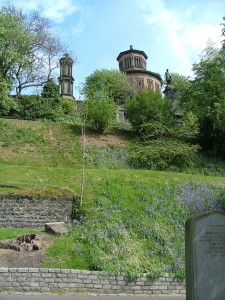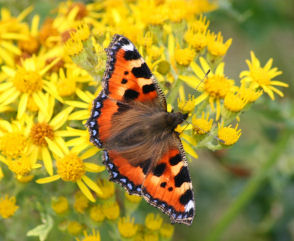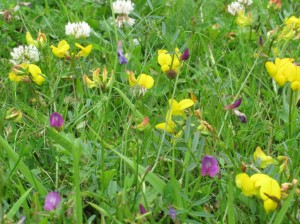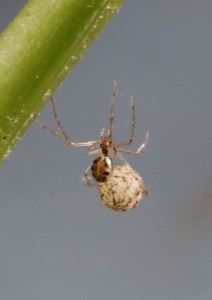This article was written by Richard Weddle.
The Necropolis is the second-largest greenspace in the centre of Glasgow, and its wooded areas, sandy slopes, and ivy-covered quarry-face, as well as unmown flowery corners provide great diversity of habitats for wildlife. It is designated by Glasgow City Council as a Site of Importance for Nature Conservation (SINC).
The ‘hump’ of The Necropolis is formed by a dolerite sill which stretches some distance eastwards through Dennistoun. The dolerite was formed many millions of years ago by volcanic activity, and was later worn down by glacial action which also built up banks of light sandy soil to the west – a feature known as ‘crag and tail’. These slopes are now covered by mature trees, and of course there have been trees here since at least 1717 when the Fir Park was established – so it is perhaps not surprising that a hoverfly associated with ‘ancient woodlands’ has recently been found on the south-west slopes.
Drifts of Bluebells (Wild Hyacinths) in the spring are one of the glories of these slopes. Some notable plants have also been found here in the past, including Heath Pearlwort and Stag’s-horn Club-moss. Though neither has been seen in recent years, we hope that a revised mowing regime on these slopes will allow them to reappear. In all, 219 species of flowering plants and trees, as well as eight ferns, a horsetail and the club-moss have been found here. These figures do not include some of the plants used in creating wildflower areas since September 2010.
The Bluebells (Wild Hyacinths) are also host to the larvae of two hoverflies: Merodon equestris, which is a master of disguise in that it has several forms, each of which mimics a different species of bumblebee in the hope of discouraging predation by birds; and in 2011 we were very pleased to find the aptly-named Eumerus funeralis (the lesser bulb-fly), the first time this had been noticed in the Glasgow area.
Solitary bees also like to build their nests in the light soils; four species have so far been found on flowers in The Necropolis: Colletes daviesanus, Andrena clarkella, Lasioglossum smeathmanellum, and Halictus rubicundus – the last three are the only records in Glasgow, though they probably do occur elsewhere. There is also an occasional honey bee; these seem to be rare in most parts of Glasgow these days, so the most frequent pollinators are the bumble-bees (five species), hoverflies, and later in the year, common wasps.
Thirty-two different species of hoverfly have so far been found in The Necropolis, including the ‘ancient woodland’ species mentioned above; this is so far the only place in Glasgow where it (Ferdinandea cuprea) has been found, though there are perhaps older woodlands – in Pollok Park for example. Another hoverfly, Scaeva pyrastri, rather more striking in appearance than the Ferdinandea, is found in the Necropolis and occasionally elsewhere in Glasgow and surroundings, though officially described as ‘scarce in west Scotland’ as it migrates annually from northern Europe.
There is also a rare species of lichen (Lecania cyrtella) to be found, along with at least thirty other kinds of lichen growing on the tree-trunks or on the stones. Lichens are sensitive indicators of atmospheric pollution, so it is encouraging to see so many species flourishing in the city centre; no doubt in former years they would have been much scarcer.
In the early spring, butterflies such as Small Tortoiseshell and Peacock reappear after the winter cold; the next generation appears in the late summer and autumn, when they are joined by the Red Admiral. The Small Copper likes to bask on the sunny south-east-facing slopes in summer, and others such as Meadow Brown, Orange-tip, and Ringlet can often be seen on sunny days basking, visiting the flowery edges, or just passing through. The latter species is a relative newcomer to Glasgow.
Roe deer are perhaps the most well-known denizens of the Necropolis, though not often seen by day in recent years. A grey squirrel or two can be seen on most days, rabbits appear occasionally, and Common Pipistrelle bats can be seen patrolling the tree canopy at dusk on warm evenings. These are doubtless outnumbered by the wood-mice and voles, which are seldom seen though they occasionally leave signs of their presence – such as gnawed cherry-stones.
The birds that have been seen (or heard) so far include Blackbird, Bullfinch, Chaffinch, Dunnock, Goldfinch, Great Tit, Greenfinch, Kestrel, Long-Tailed Tit, Magpie, Mistle Thrush, Peregrine Falcon, Robin, Sparrowhawk, Starling and Wren; thirty-two species in all so far. Some of the residents nest in the ivy which covers the former quarry-face, and feed on insects and spiders, or on the seeds and berries of the various flowering plants and grasses.
Some of the plants introduced to the wildflower area in 2010 are coming up well. However others are being outgrown by rank grass, and it may be necessary to remove the topsoil and re-plant. The photograph shows the neighbouring area, formerly overgrown with knotweed, has now come up with a colourful floral display which we’re hoping will continue in future years if suitably managed. The ‘scrambled-egg’ slime mould appeared on the grass here in 2011.
Further wildflower planting was done in 2022 to delineate the area containing unmarked graves in Eta.
Particularly on the old quarry-face, ivy is a fantastic wildlife resource; as well as providing a good nest-cover for birds, it is home to the hawthorn shieldbug and other insects, as well as numerous spiders and harvestmen. In the late autumn the ivy flowers are a valuable nectar source, particularly for moths. And of course it has a significant effect on the ‘atmosphere’ of any cemetery, as well as its symbolism (for the poet Byron) as ‘the garland of eternity’, and as such it can also be seen carved on some of the memorial stones.
In 2012 The Necropolis made the news through the discovery of what was believed to be the first occurrence in western Europe of a North American comb-footed spider Rugathodes sexpunctatus (it then transpired that one had been found shortly before in Bearsden). The photograph shows a female with an egg-sac which she carries around for safety. This find gave rise to some more detailed searches which have added yet another ‘first’ for Glasgow – the rather rare rove-beetle Acidota cruentata. The rove-beetles are perhaps best known through the biggest British member of the group, the Devil’s Coach-horse (Ocypus olens); this is quite common in The Necropolis and is another insect which could be said to aptly found in a cemetery – in Irish folklore it is believed to eat the flesh of sinners! They are known to eat carrion, but also earthworms, slugs and other invertebrates.
In 2022 a spider find in The Necropolis again made the news: this time it was a very small comb-footed spider Cryptachaea blattea, only the second record in Scotland. The finder went on to add another 20 spiders to the Necropolis list, bringing the total number of species to fifty-eight.
At least four different ladybirds live in the Necropolis. As well as the ‘common’ seven-spot ladybird and the perhaps even more common two-spot ladybird, the orange ladybird can be found, particularly on the underside of leaves of sycamore and its cousins the maples, where it feeds on mildews growing on honeydew exuded by aphids; the cream-spot ladybird can also be found there or nestling in cracks on the trunks of birches. These are all out-numbered by the Red Soldier-beetles which can be seen on or flying around flowers such as ragwort in the late spring and summer.
There are also slugs and snails and other, some would say, less-attractive creepy-crawlies such as earwigs (horny gollochs) and centipedes (three species) and woodlice (three species). Apart from these and the insects already mentioned, there seems to be a lot still to learn about the invertebrate population of the Necropolis – the same could be said for many of the other greenspaces in Glasgow. The main groups that need to be investigated are the moths, beetles, flies (other than hoverflies), and spiders, together with the mosses and fungi.
See Species List for a complete list of species that have been found in the Necropolis so far.
Most of the information in this account is taken from the wildlife database of Glasgow Museums Biological Records Centre; please contact biological.records@glasgowlife.org.uk for further information, or to report wildlife sightings from anywhere in the Strathclyde area. Any opinions expressed are those of the author.
—
Please visit our Monteath Appeal page













